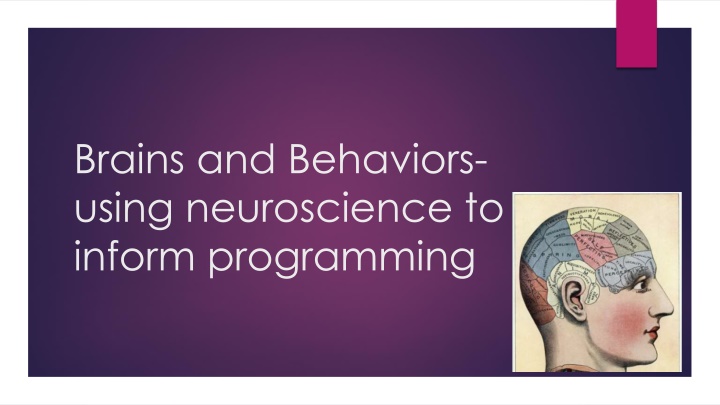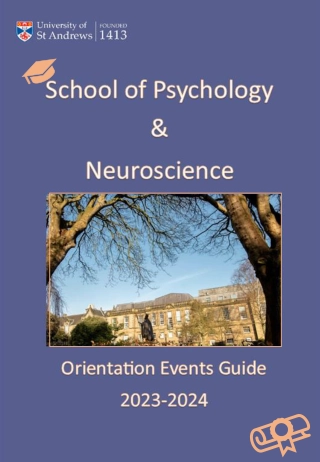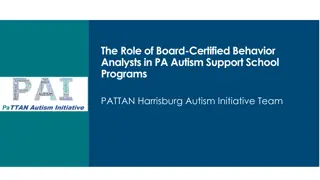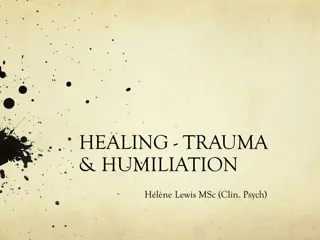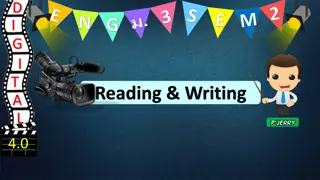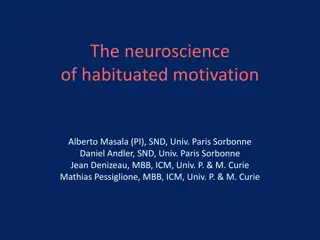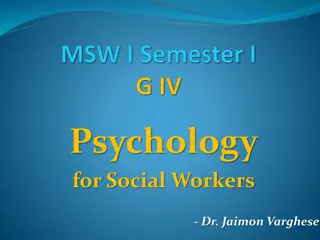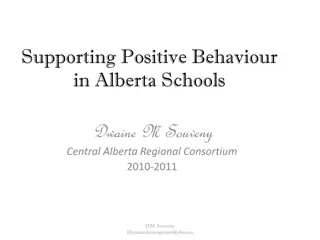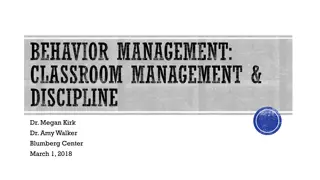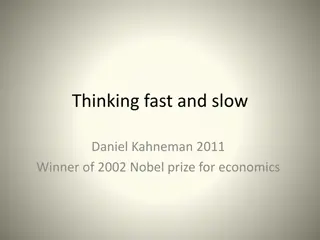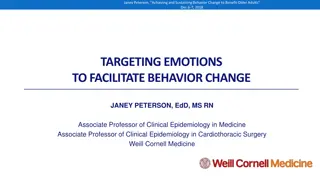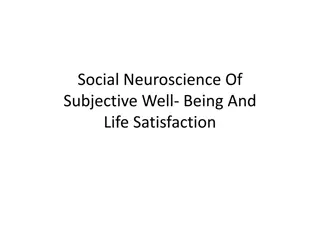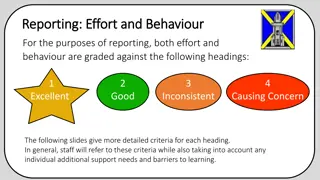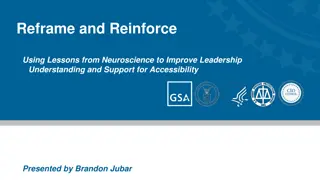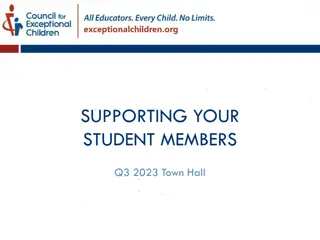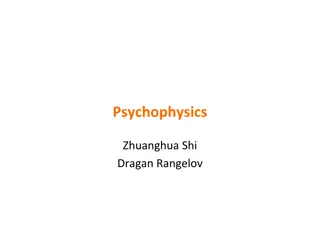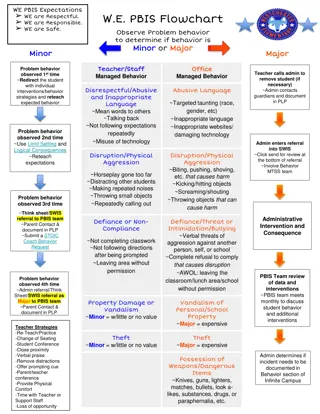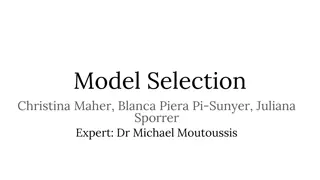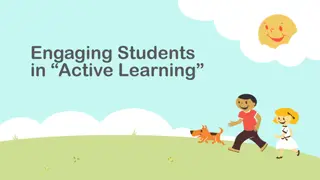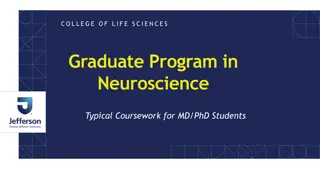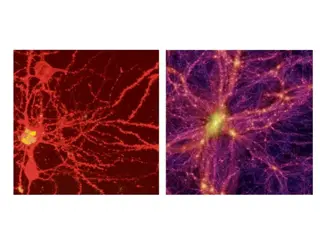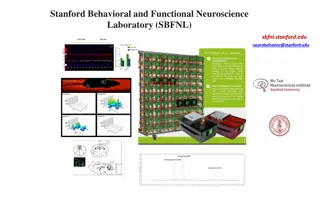Supporting Student Behavior Through Neuroscience
Utilize neuroscience to inform strategies for supporting student behavior. Explore brain development, positive behavior interventions, and understanding why students misbehave. Empower students by developing self-awareness and implementing effective support systems.
Download Presentation

Please find below an Image/Link to download the presentation.
The content on the website is provided AS IS for your information and personal use only. It may not be sold, licensed, or shared on other websites without obtaining consent from the author.If you encounter any issues during the download, it is possible that the publisher has removed the file from their server.
You are allowed to download the files provided on this website for personal or commercial use, subject to the condition that they are used lawfully. All files are the property of their respective owners.
The content on the website is provided AS IS for your information and personal use only. It may not be sold, licensed, or shared on other websites without obtaining consent from the author.
E N D
Presentation Transcript
Brains and Behaviors- using neuroscience to inform programming
How can we best support our students? 1. Take care of ourselves 2. Be honest with ourselves and each other 3. Identify our own patterns of behavior and make changes to the negative patterns 4. Identify our program s patterns of behavior and make changes
How Do Brains Develop? Back to front Billions of neurons 20% connected at birth Skills and Practice and Modelling
Positive Behavior Interventions and Supports helps build neural circuitry Clear expectations expressed through modeling, teaching, practicing, and visuals Program-wide acknowledgement system for students to get positive feedback for the behaviors we want to see Ratio of Interactions where positive outweighs negative and relationships are built Using our building resources/strategies- do not re invent the wheel!
The Program Vibe Positive endorphins/dopamine Attentive and Interactive/Thinking Brain Negative increase cortisol Survival Mode/Emotional Brain/On Alert
Behavior is Communication
8 Why Do Students Misbehave? Because they: Don t know what is expected Forget what is expected Don t have the skill to do what is expected Don t value what is expected Are processing other material Get something from their misbehavior
Dont know what is expected Forget what is expected Don t have the skill to do what is expected Don t value what is expected Are processing other material Get something from their misbehavior TURN AND TALK TELL YOUR NEIGHBOR: 1. ABOUT A STUDENT YOU CAN THINK OF WHERE ONE OF THE ABOVE APPLIES TO THEM 2. DESCRIBE WHAT THAT LOOKS LIKE IN YOUR PROGRAM 3. HOW CAN YOU/HAVE YOU SUPPORTED THE DESIRED BEHAVIOR?
What do we do?? Teach and Re-teach the Skills Visual Reminders Acknowledge different values Positive Attention Decrease Distractors Talk to parent/teacher What works at home/in the classroom?
Relationships Increasing Positive Attention Program-Wide Greeting at the door- fresh start Asking for input during the program Invite students to ask for assistance (e.g. let me know if I can help) Have authentic conversations with students Make a special effort to interact with any student you ve spoken to about misbehavior Ratio of interactions
Power Struggles Decrease if we are Proactive instead of Reactive Can t make you do it- but really need your help. You want this and I want that- this is the challenge-what can we do about that? Effective, efficient feedback 10 words or less- 1 is best! Legos backpack pens floor Use your visuals not your voice Share what you WILL do with kindness always present We will hand out snack when you are seated
Glad to Be Here! Benefits to Students and Staff More Connections Students will see you modelling pleasant supportive social interactions Student behavior will improve- mirror neurons Each day will be more pleasant, resulting in an improved program climate for you and the students
Bottom lineYou are integral in building the Executive Functions of the Brain* Goal setting/problem solving Planning a project Inhibitory control Simon Says/Red Light Green Light/Connect 4 Working memory Songs or poems Cognitive flexibility Practicing perspective taking/Apples to Apples Coordinating feeling and thinking Feedback form/Making an appointment
What Do Our Older Students Want? Choices Fun Leadership opportunities To be understood Separation/Distinction Different acknowledgement system Different snack table Different responsibilities Power Freedom
Leadership Skill Building Model leadership behaviors What are you doing and why are you doing it Build up slowly Small opportunities with room for growth Lots of Cooperative Games Distinct Day of the Week Explore interests Role Plays/Problem Solving Scenarios Skill Building Teaching a lesson Reading to a younger child Leading a game
Specific student jobs that have worked Ball Collector Snack Helper Eyes and Ears Ref-ing games Leading Circle Assistant teacher during lesson plan Game Leader Recess Helper Student Voice at Monthly After School Staff meeting
Specific Projects that have worked Community Volunteering Bike Project Re-teaching favorite lesson plans Fundraising for specific organizations Monthly bigger craft project/Talent Show Reading Buddies Teacher /Sports Assistant Scavenger Hunt Clubs Action Hero Adventure Club
Cross Age Activity Ideas Have cross-age buddies . Have the older kids learn about something and prepare it to present to the younger kids. Then switch, and have the youngers do the same for the olders. Have the older kids teach and play a game with the younger kids. Have the older kids read to the younger kids and then together create a storybook. Pair the older and younger kids to be partners on a walking field trip. Let the older kids plan a festival or event and invite the younger students.
Potential Barriers Rigidity of Grown-ups Has to be a priority for the adults Staying within ratio Floater 1 day of week a possibility? Sight and sound for compliance Shared space Separate table/Separate corner Transitioning staff Students can help train new staff
SCENARIO 1. DURING A WHOLE GROUP MEETING, THREE 4TH GRADERS ARE DISRUPTING THE DISCUSSION ABOUT THE PLAN FOR OUTSIDE PLAY. WHILE THE TEACHER IS EXPLAINING TWO NEW OUTDOOR GAMES, SHE NOTICES THAT THE YOUNGER CHILDREN ARE EXCITED AND ACTIVELY LISTENING, BUT THE 3RD GRADERS ARE FOCUSING ON THE 4TH GRADERS. AND THE 4TH GRADERS ARE CAPITALIZING ON THAT ATTENTION AND GETTING MORE VOCAL AND DISRUPTIVE. IN THIS SCENARIO, WHAT WOULD YOU DO DIFFERENTLY TO ACHIEVE BETTER BEHAVIOR OUTCOMES FOR ALL STUDENTS? Scenario #1
Problem Solving Ideas Older students write out rules to the new game and model how to play it Have mixed age groups sit together during the meetings Families Separate the 4th graders out and ask them to take notes and gather the supplies for the game- they will likely need less instruction for a new game than the littles. Have a meeting with older kids at another time and reinforce that they are leaders and the younger children watch them for behavior cues
SCENARIO 2: OUTSIDE TIME DID NOT GO WELL TODAY. CHILDREN PLAYED IN THE FAR FIELD, WHICH IS NOT ALLOWED. A SMALL GROUP OF STUDENTS DISRUPTED ANOTHER S GROUP S GAME OF CAPTURE THE FLAG. AFTER THE TEACHER BLEW THE WHISTLE TO GO INSIDE, IT TOOK 15 MINUTES FOR STUDENTS TO LINE UP. THE STUDENTS WHO FOLLOWED DIRECTIONS AND WERE IN LINE ON TIME HAD TO WAIT FOR OTHERS TO JOIN. THE TEACHER FELT THAT THE GROUP WASN T FOLLOWING THE RULES, AND DIDN T SEEM TO CARE ONE WAY OR THE OTHER. SHE WAS TRYING TO FIGURE OUT HOW TO TURN THIS AROUND FOR TOMORROW. WHAT DO YOU RECOMMEND? Scenario #2
Problem Solving Ideas Re-teach outside expectations and reinforce every time Have older students be a part of designing that lesson Fun activity to return to the building for Slowest movers are in charge transition notification (whistle, bell, attention getting signal); keys to open the door etc. Contest to see how fast they can get in line Empathy building activities/restorative circle w someone skilled in RJ What do you like about the game? What problems have occurred when the game is played? What can I personally do to make things better? Common agreements
How can we best support our students? 1. Take care of ourselves 2. Be honest with ourselves and each other 3. Identify our own patterns of behavior and make changes to the negative patterns 4. Identify our program s patterns of behavior and make changes
Kid President 20 THINGS WE SHOULD SAY MORE OFTEN
FIND YOUR TEAM SOMETHING YOU WANT TO TRY WHAT NEEDS TO HAPPEN? WHO IS RESPONSIBLE FOR FOLLOW-THROUGH? HOW WILL WE CHECK BACK IN? WHAT SPECIAL SKILLS DOES YOUR TEAM HAVE? 1. 2. 3. 4. 5.
